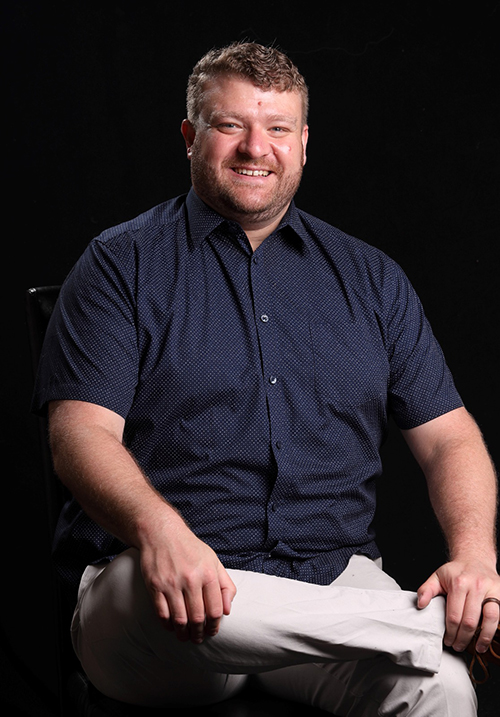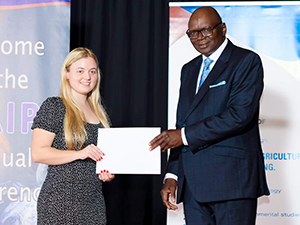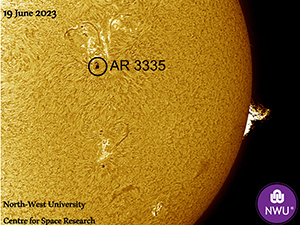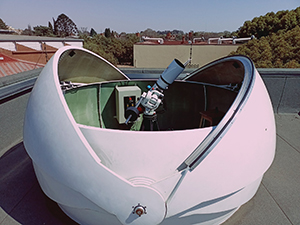Located on the roof of building G5 at the North-West University’s (NWU’s) Potchefstroom Campus, the solar telescope of the Centre for Space Research has garnered attention from organisations such as the BBC and the Royal Astronomical Society.
Dr Ruhann Steyn, senior lecturer and principal scientist involved in the project, recently attended the National Astronomy Meeting in Cardiff, Wales, where he was commended for the outstanding work done by the Centre for Space Research.
The idea for the solar telescope originated from a growing interest among staff, students and the international research community to delve deeper into solar physics. While the Centre for Space Research focuses on astrophysics and heliospheric physics, which explores the sun's influence within the heliosphere, the study of solar physics had not been extensively pursued at the NWU or in South Africa. This field focuses on the sun's mechanisms, layers, active regions, sunspots, solar flares and more.
The project's development occurred in several phases. Initially, in 2017, funding was sought to establish a proof-of-concept with a small solar telescope and a rudimentary mount. The team procured a dedicated Hydrogen Alpha solar telescope, a basic camera and a white light telescope for night viewing.
These instruments facilitated student projects, enabling the capturing of images of the sun over consecutive days to track sunspots, and study their movements across the sun's disc. This initial setup highlighted the need for a more automated and permanent observation station, as manually capturing images under the sun for extended periods was impractical and posed occupational health risks.
Setting up a permanent station
Subsequently, the team applied for additional funding to establish a permanent station, featuring a dome and a remotely operated mount for the telescopes. The NWU’s Instrument Making department undertook the challenge of designing and constructing a dome capable of withstanding the extreme temperatures and conditions specific to South Africa, particularly Potchefstroom.
The successful collaboration resulted in the creation of a custom-built dome, paving the way for the installation of the fully functional solar telescope in the second half of 2021.
Various stakeholders played integral roles in the project’s success, including the School for Physical and Chemical Sciences, the Centre for Space Research and the Instrument Making department. These entities were instrumental in securing funding, support, research and guidance in the navigation and realisation of this intricate and innovative project.
The significance of the solar telescope lies in its ability to extend the research repertoire of the Centre for Space Research into solar physics. Unlike other astronomical objects, the sun's proximity and size make it accessible for study without the need for prohibitively expensive equipment. Solar studies align well with existing research on space weather, sunspots, differential rotation rates and prominences – dynamic phenomena that influence space conditions and can impact technological systems, such as satellites.
By gathering valuable data, the solar telescope contributes to a global network of researchers working towards forecasting solar activity and developing proactive measures to safeguard satellites and ensure safe interplanetary travel for astronauts.
Dr Steyn's recent submission to the National Astronomy Meeting highlighted the solar telescope's capabilities and the value it brings to the international research community.
The presentation also showcased the results of honours research conducted by Calmay Lee, an instrumental contributor to the solar telescope project. Calmay's work earned recognition at the South African Institute for Physics Conference, where she received the Honours Encouragement Prize in Space Science.
Looking forward, Dr Steyn aims to establish a dedicated solar physics research group within the Centre for Space Research. This group will consist of researchers and a cohort of students who will focus exclusively on solar physics. By capturing hourly or daily images of the sun and making the data accessible to the global research community, the group aims to showcase the capabilities of this solar telescope and subsequently add value to global solar physics research.
Dr Steyn envisions marketing these world-class images, now generated in the southern hemisphere, to enhance the NWU's reputation in solar physics research and foster collaborations within the scientific community.
Driven by a growing interest in the sun's dynamics and its impact on space weather, this innovative project has successfully established a capable and automated solar observation station and represents a milestone in solar physics studies in South Africa.

Dr Ruhann Steyn, senior lecturer and principal scientist on the solar telescope project.
.jpg)
The Centre for Space Research's solar telescope.

Calmay Lee receives the Honours Encouragement Prize in Space Science at the South African Institute for Physics Conference.

An image taken using the Centre for Space Research's solar telescope.

The solar telescope is mounted in the hi-tech dome, designed and built by the Instrument Making department.
